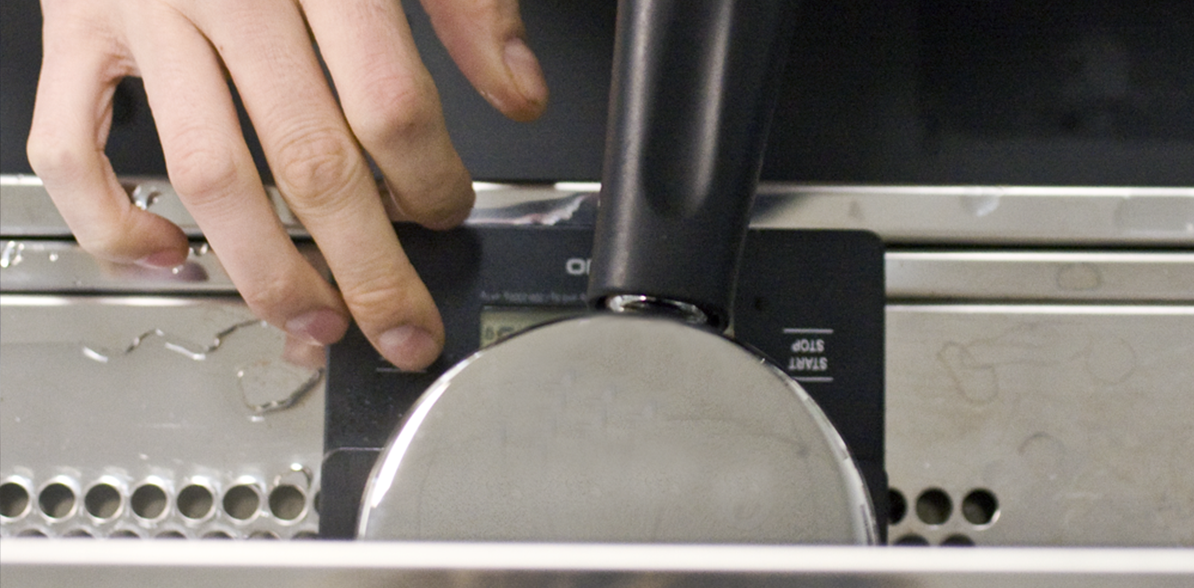
Semi- vs. Superautomatics
Choosing between semi- and superautomatics is often the first of many decisions made on the hunt for a home espresso machine. But what's the difference between them, and which is better? These are two of the most common questions our customers ask us as they prepare to jump into the home espresso game.
Let's address the second question first. We stand firmly behind all of the espresso machines we sell, semi- and superautomatics alike — we would never recommend a poorly-made machine. We also service almost all of the machines we sell, so our technicians can attest to the quality and longevity of the various models and brands. It really isn't a question of whether semi-automatics are superior to superautomatics or vice versa — what's more important is whether or not a machine truly suits the home barista's routine and coffee “objectives”. The world's best espresso machine isn't any good if the user doesn't like to use it.

Steaming milk for a latte on the Rocket Giotto espresso machine.
So it's all about YOU, the barista. Do you like the idea of a hands-on coffee-making experience? Are you keen to master traditional espresso-making and milk-steaming techniques, even if the learning curve's a little steep? Not too worried about wet and dry coffee grounds accumulating on your counters (and maybe the floor) as you work? Or do you prefer an efficient all-in-one package that delivers consistent results without supervision?
If you relate more to the latter, you'd probably prefer a superautomatic.

Shots pouring from the Jura Z6 espresso machine.
SUPERAUTOMATICS
It grinds, tamps, froths, and churns out specialty coffee beverages at the push of a button. It delivers consistent results with every use, and takes up a relatively small amount of counter space. The superautomatic espresso machine is ideal for the coffee lover that wants a delicious beverage made in moments with very little muss or fuss.
Though they can vary widely in features and programmability, superautomatic espresso machines are all fairly similar in fundamentals: a brew unit, coffee grinder, water tank and bean hopper are housed within one economical unit and controlled by a digital power board. Some of them also have frothers that steam and texturize milk automatically; One-Touch Cappuccino machines will make espresso and add steamed milk in one go, while others require an extra step between making espresso and frothing milk. A number of functions can be programmed according to taste, such as temperature, coffee strength, brew volume, etc. Generally, superautomatics heat up fairly quickly — some brands even boast instantaneous operation — so you can turn the machine on and begin making coffee within moments, whereas semi-automatics can take as long as 20 minutes to heat up.

A cup of coffee, freshly-made on the Jura J6 espresso machine.
Most superautomatics will perform routine rinse cycles before and after each use, and they usually tell you when they require a more comprehensive cleaning. The machine will perform this function on its own as well — it just requires the addition of espresso machine detergent or other specified products. Some models can also have their brew units removed for an occasional cold-water rinse. Other than that, regular maintenance simply consists of emptying the spent grounds bin and drip tray.
Initially, it may seem like superautomatics cost more than traditional espresso machines. While this may be true in some instances, remember that traditional espresso machines also require a good-quality espresso grinder, and the combination can bring the cost a little closer to par. Service rates for superautomatics, on the other hand, are necessarily higher due to the complexity of the unit and the more substantial digital components.

Shots pouring from the Rocket Giotto espresso machine.
SEMI-AUTOMATICS
On the other hand, if you're more of a hands-on coffee enthusiast with a penchant for traditional espresso-making, you'll probably prefer a semi-automatic espresso machine. These models more closely resemble the ones you see in specialty coffee shops, where the barista grinds the beans, fills the portafilter, tamps, initiates and terminates extraction, steams and pours the milk, and empties the portafilter, sometimes performing the cycle hundreds of times over. If you're ready to learn that process, and if you don't mind the inevitable bit of debris in your workspace, a semi-automatic will be a great coffee-making companion.

A shiny new ECM Synchronika espresso machine.
Let's be clear — every new espresso machine comes with a learning curve of some sort. But a semi-automatic espresso machine has a learning curve that can end pretty quickly, or carry on into infinity if you really want to delve into the art and science of specialty coffee. It doesn't take much to master the basics of grinding, dosing, tamping, and steaming — some models have features that take some of the guesswork out of the equation, and we even host classes for budding home baristas — but if you're so inclined, you can turn the fine-tuning and finesse of coffee into a life-long hobby. Once you get the hang of using them, semi-automatics give you much more control over espresso quality as well as milk temperature and texture.

Dialing in a shot on the Rocket REA espresso machine.
And then, there's the grinder. A good-quality burr grinder is essential to producing good espresso. Some folks get by with pre-ground espresso, and others limp along with blade grinders, but neither option consistently yields the kind of results most espresso-lovers are looking for. Grinders range in price, purpose, and quality — you needn't break the bank, but be sure to do some research or consult a knowledgeable dealer. Furthermore, having a grinder that's separate from the espresso machine means you're free to invest in the initial purchases and/or upgrades of one machine at a time — and even if one breaks down, the other's still in the running, whereas a superautomatic would be entirely out for the count.

Grinding espresso with the Rocket Fausto.
Just as the drink-making process is much more hands-on, so too is the cleaning routine of a semi-automatic. Backflushing with a blind portafilter and specialized detergent is essential to the health and sanitation of the machine. The portafilter and group head also need a little scrubbing, and the steam wand is a commonly neglected trouble spot. We recommend taking both semi- and superautomatic espresso machines in to be professionally serviced every couple of years, so authorized technicians can replace gaskets, renew lubricants, check the valves, and clear out any residue built up in the areas beyond the reach of regular cleaning routines. This will significantly extend the life of a machine and improve the quality of coffee it produces.

The myriad wires inside a Jura superautomatic espresso machine.
So there you have it - a brief overview of the semi- vs. superuatomatic espresso machine comparison. Hopefully this helps in the big decision of which espresso machine to bring home. If you have any questions, comment below or get in touch with our sales team!

Leave a comment